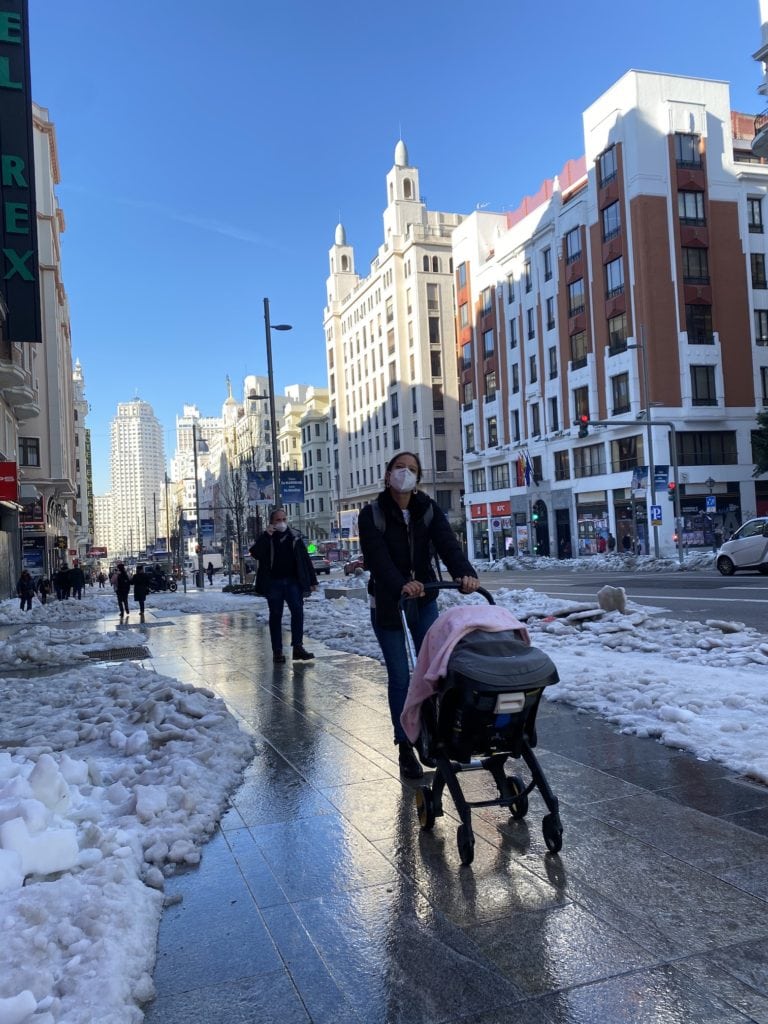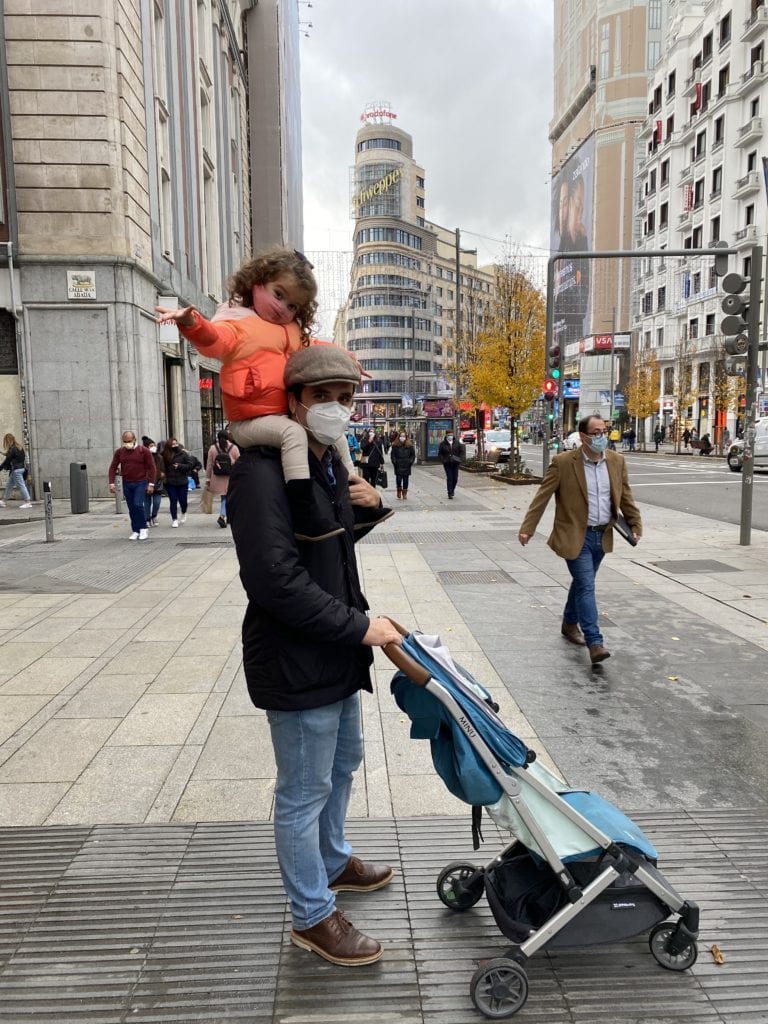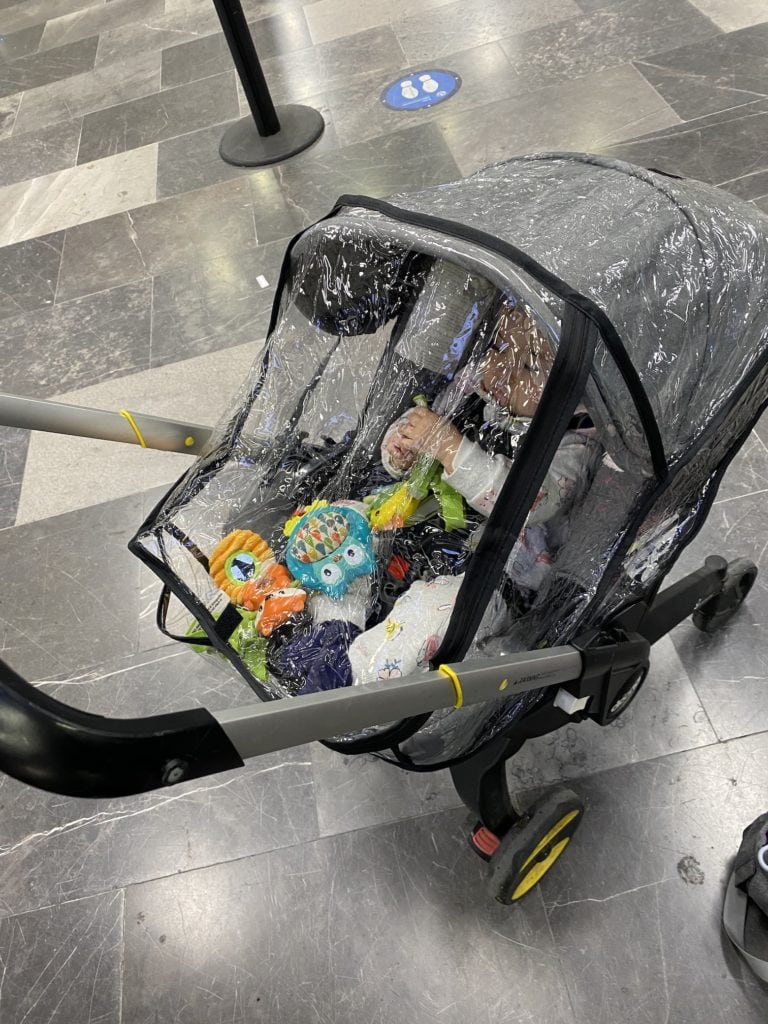This post is also available in: Español (Spanish)

Last December, my husband and I traveled with our two small girls (an 8-month-old baby and a 3-year-old toddler then) and got on a plane to Spain. We decided to venture into flying with kids during Covid because my brother-in-law was getting married, and we had been away from family for a long time.
We managed to “survive” an 18-hour long itinerary with two little ones and made it safely to our family’s house, without getting infected or passing on anything to our loved ones.
With this post I intend to share our own personal experience traveling with kids and not offer any medical or health advice. You should go to the CDC website to get informed about their official travel suggestions and ask your doctor if you have any medical questions.
I will give you my thoughts though, and I must say that the safest thing to do right now is to stay home. If for any major family or work reason you need to travel by air during the pandemic, I wish you the best of luck. Hopefully the following tips will help you in some way!

1. Research how the pandemic is handled where you are traveling
Each country /state has implemented lots of restrictions and requirements for people arriving by car or plane. You can usually find most relevant info on each country’s government (or official state) page and even on the main airport’s page. Some places like the US require a negative Covid-19 test performed up to three days before traveling, some countries aren’t even allowing the entrance of non-nationals or permanent residents.
In our case, we were approved to enter Spain because my husband is Spanish, our daughters have Spanish nationality and I have a French passport, but I understand travel was restricted to non-citizens at that time.
2. Try to book night itineraries
This was always my case when we traveled with our firstborn during her first year (I think she got into over 20 planes in under a year!), since it’s helpful that, come night time, your kid will probably want to go to sleep. Night time flights also mean less movement around the cabin from others. If your flight is not too long, it’s helpful to book it during the child’s typical nap time.
3. Bring extra of everything
Face masks, hand sanitizer, disinfecting wipes, and clothes. I always carried a small hand sanitizer with me in my back pocket and had multiple others. At the end of this post, I’m sharing my diaper bag and hand luggage packing list in case it helps.
4. Board early, to have time to sanitize your seat
Even if your airline assures you that they “wipe down” the aircraft very well in between flights, there can be different standards as to what wiping down means to each airline, and even the cleaning person’s standards can be different than yours. I just preferred to be extra careful, especially traveling with kids and considering that our baby would touch ANYTHING that was in her way.
5. Open the air vents
Many airlines have revamped their air systems to include HEPA filters, which filter out 99% of air particles, but it doesn’t hurt to allow more air to keep flowing. This is also the reason why we traveled with at least a couple of layers on, to keep warm during the flight.
6. Try to book the “safest” seats
According to different sites I read about air travel during the pandemic, the window seat is the one with the least interaction with other people. However, it’s understandable if for a long transatlantic flight like hours you’d like to get an aisle seat – I would just recommend finding one that’s not near any common areas (the coffee area/the bathrooms), which usually see more traffic of people passing by.
7. Minimize time spent without a face mask
If you haven’t been fully vaccinated or if you have and are going to be in places with people who aren’t fully vaccinated, it is still crucial to wear a face mask at all times to prevent transmission. Back then no vaccines were available anyways so I preferred to be extra careful in smaller, less ventilated spaces. To avoid spending too much time without a face mask in “riskier” places like a plane, we ate dinner before boarding and just brought along snacks that we could easily slip under the mask, like dried mango pieces and fruit gummies.

8. Protect baby from airborne transmission
Babies can’t wear a face mask so it’s a little trickier to try to protect them from any damaging airborne particles. To minimize this risk, we bought a rain cover that fit our Doona stroller to use at airports, since we had a 2-hour layover and, in the plane, we just tried to keep the baby with whichever parent had the window seat. On the flight going to Spain, she slept almost 10 of the 12 hours of the direct flight. She was on me pretty much the entire time and I wore a poncho-like shirt that worked perfect for nursing and for giving her a comfy cover when she was sleeping on my chest.
9. Book itineraries that have flexible, long durations
This goes for layover time, as well as trip duration. You never know how the security processes at airports might delay the usual time it takes to pass through security or go from one terminal to the other.
Since the state of the pandemic evolves quickly, it’s hard to say that the place where you are traveling won’t change its security measures from one day to the next and perhaps prevent you from traveling back to your country.
Luckily, the travel industry has been very understanding and many hotels and airplane companies are flexible to offer longer stays, or let you change your itinerary either free of charge or at a discounted price, if you experience any trip changes due to Covid-19. It never hurts to have a Plan B.
10. Use your voice
If you see someone around you not complying with the safety measures (of wearing masks, covering while coughing, etc), tell the stewardess or whoever has the authority to enforce the measures. Don’t feel bad, you might help save a life!
For instance, I had to blow the whistle on a man who refused to have his mask cover his mouth and nose. He was sitting right across the aisle from me and took advantage of the lights dimming to lower his facial covering. After a while, He coughed a couple of times and that activated my anxiety. I called someone and they politely asked him to put the mask on. He then proceeded to fake to be asleep, so the stewardess kept on pressing, telling him she was going to get one of the pilots. Surprisingly he “heard her in his sleep”, and proceeded to raise his mask to the right position. #sorrynotsorry
11. Quarantine and get tested once you reach your destination
The CDC recommends getting tested on the 3-5 days after arriving from air travel or quarantining at least 2 weeks to avoid transmission. Now there are many types of tests you can do to feel safer, just keep in mind the efficacy of each. Some destinations make this testing and quarantine period mandatory but, regardless if it’s mandatory or not, if you care about the people around you, you should take these recommendations seriously.
See below for what I packed in each of the cases we brought on board with us! (*printable version with checkboxes at the end!)
FLYING IN A PANDEMIC PACKING LIST
Personal strap bag
- Passports inside a plastic makeup bag
- Disinfecting wipes (I prefer these)
- Hand sanitizer (I tend to use these small ones and this one from The Honest Company)
- Money inside a plastic makeup case: cards and cash inside a Ziploc bag
- Face mask inside its own Ziploc bag
Hand luggage
- Baby carrier (mine is Ergobaby Omni 360)
- Laptop
- 1 change of clothes for mom + sock slippers
- 1 change of clothes dad + socks
- 1 change of clothes toddler
- Folder with long documents (test results, etc.)
- Vanities: toothbrushes, face wash,
- Diapers: 3 pull-ups, 5 baby diapers (we use Pampers Pure)
- Extra PPE (2 extra face masks for the grownups and 2 for the toddler)
- Extra disinfecting wipes
- numerous Ziploc bags in different sizes (to store dirty clothes/masks/toys, for anything!)
- The stroller’s plastic cover (technically a rain cover)
Diaper bag / Backpack
- Baby pajamas
- Change of clothes for baby
- Medium-weight blanket
- Extra undershirts and socks for baby
- Extra chewable toys
- Baby food: dinner + breakfast + 2 formula bottles
- A couple of baby spoons (these are great!)
- Snacks for toddlers: fruit
- Extra bottles of disinfecting gel
- Foam hand wash for baby (We love this one!)
- Diapers: 1 pull-up for toddler, 4 for baby
- Baby wipes
If you want to learn more tips and read my family’s stories, you can check more posts here.


Leave a Reply